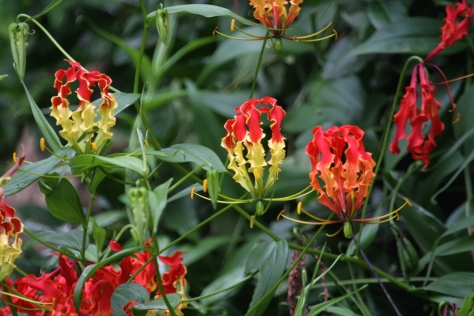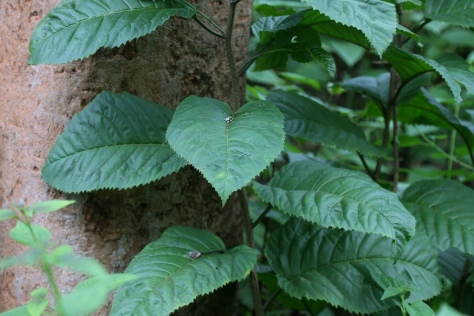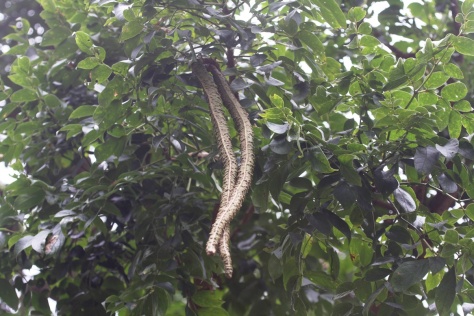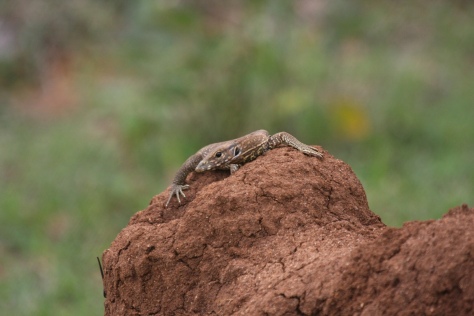Dates: 2 – 5 Sep ’16
Camp: K. Gudi Wilderness Camp
Who: P

Glory Lilly (Gloriosa superba) by the roadside a short way from the camp
My kid P and I did three nights this time. The weather was cool with some spells of rain. Sightings were not particularly great as a result, but the forest was hauntingly beautiful, and straight out of a Grimm’s Fairy Tales movie set one particular morning, with a thick mist hanging over it.

Brown fish owl, early in the morning
Visibility was poor due to luxuriant growth of Eupatorium Ageratina adenophora, Lantana Lantana camara and Bracken Pteridium aquilinum. These three weeds dominated the ground cover and it is very likely that they have had a deleterious effect on the herbivore population over the years. And this possibly explains why the large herds of gaur that were once plentiful in BRT are nowhere to be seen today. Elephants have become scarce too. The only consolation is that there is not much Parthenium hysterophorus . The post-monsoon clearing of vegetation by the track will not happen for another month. The undergrowth was tall enough to completely hide a leopard or sloth bear, making sightings possible only if the animal was on the track itself. Due to this reason, Durgur road, which is usually unfailingly productive on the way out (in the evenings), drew a blank this time.

Another insidious plant that I should have noticed earlier but somehow hadn’t was the hemiparasitic Mistletoe Loranthus sp. It infested a majority of the Axlewood Anogeissus latifolia trees, leaching nutrients and water. I heard that it had almost completely decimated the Indian gooseberry Phyllanthus emblica trees.

The darker leaves are from Mistletoe (Loranthus sp.), a hemi-parasite.
The birding was okayish, not too great. Grey wagtails had started to arrive a week back and were plentiful. I learnt to ID the vaguely squirrel-like call of the Orange-headed thrush. This call resonated frequently through the camp and the jungle as these birds were everywhere too. There is another call, a more frantic one, which is not quite as distinctive. I also got familiar with the Blue-bearded bee-eater’s call, given that a pair was constantly (and noisily) haunting the surroundings.

Orange-headed thrush outside tent No. 7
I also puzzled over a call that sounded like the Stork-billed kingfisher’s except that it had four continuous notes in place of the usual two (or three). Rahul, an avid birder from Bangalore who was visiting indicated that this was the winter call of the Stork-billed kingfisher. Rajesh, my good friend, spotter extraordinaire and favourite driver was puzzled; he said he hadn’t seen this bird around.

Jungle babblers behind the Gol Ghar. They are bold enough to hop right into the Gol Ghar looking for crumbs. Pic by P.

This is a very common weed I have not been able to ID yet.
Naturalist Basavanna has shifted from Bandipur to K. Gudi and accompanied us on our drives (Narayan did too, for the first two days). He taught us to ID the call of the Drongo cuckoo. We were waiting by Anni kere when what superficially sounded like the Indian cuckoo’s call started up (except that this is not the season for the Indian cuckoo to call). And except that this was three notes up and one down, unlike the sing-song pitch of the Indian cuckoo’s.
At the same place, we also heard a repeated, drawn-out, shikra-like call which we were stumped by until Basavanna identified it as the Brown fish owl’s chick’s call.

Jungle owlet. Pic by Rajesh.

Indian blackbird in the camp
On day three, Rajesh suggested that we take a walk down the road towards the government school after lunch instead of wasting time lounging around in the tent (as he put it). We walked for a short distance until junior got too nervous to go any further – he had been rattled by the earlier sloth bear and leopard sightings around the tent. We saw an Oriental honey buzzard, a Blackbird, Blue-bearded bee-eaters, and on the way back, a Tawny-bellied babbler that showed itself clearly for quite a while, although while constantly flitting around and preventing Rajesh from getting a photograph. We also had a reasonable Rufous babbler sighting in the jungle later on.

Radermachera xylocarpa outside tent No. 7. Commonly known as the Deer antler tree.
This was a trip full of tantalizingly close opportunities that never materialized. There were plenty of alarm calls, with none converting. On day 1, in the evening safari, we were drawn to Tiger Tank by persistent Muntjac alarm calls. The deer decamped, but a troop of langurs stationed there barked hysterically and persistently, accompanied by much leaping and branch shaking. They were clearly very excited. Rajesh, Basavanna and Narayan all craned their necks trying to get a fix on which side the langurs were focused on. Two opinions eventually emerged, one pointing away from the kere, and the other (Rajesh’s) pointing towards it. A quick discussion led to a consensus that the cat must have just crossed the road and passed in a direction away from the lake. And so off we went, looking for it elsewhere. Turned out that Rajesh’s suspicion was right. The tiger (which is what it was) was hidden right there, in the sea of Eupatorium between us and the lake. It emerged an hour and a half later and was seen and photographed by another group. Rajesh was especially disappointed that we had miscalculated.

The long weekend brought a lot of traffic to the temple, further impacting the sightings. Pic by P.
On day 3, in the evening safari, we ran into another loud and persistent series of calls. Somewhat midway between the barking deer’s and chital’s alarm call. Everyone promptly assumed it was one of these and an animated discussion ensued around where the cat possibly could be. We drove around a little trying to pinpoint direction. After a while, Rajesh smacked his forehead when he realized we were in fact listening to the Spot-bellied eagle owl’s call. Although he was equally excited at the prospect of locating the owl. We did try for a considerable time, but without success and the calls eventually died out.

P (9 years old) clicked this pic of Durga Parameshwari, the camp elephant
I also missed an Indian flying squirrel sighting on day 3 in the evening. The squirrel calls had started just after junior and I had left the gol ghar post dinner. The pair was then sighted, for a period of fifteen minutes, as it progressively glided its way from the trees near the FRH to the jungle beyond the Gol Ghar. The next day I asked Basavanna why he didn’t give me a call, and his reply was that he would definitely have, had he known that I was interested in watching flying squirrels.

Chappekkai. Entada rheedii possibly. I had not realized earlier that the pods were growing off a climber and not off tree itself.

Gaur with calf. Pic by Basavanna.
Junior and I also missed a dhole sighting on the drive back. We had driven down towards the temple on day 2 with Rajesh post breakfast, looking for a pack that frequented an area a little before the BR Hills settlement. (There was another pack frequenting the Navodaya checkpost side too that we also looked for in vain). We didn’t find the pack, and there was considerable disturbance from some tar-laying work that was underway. On my drive back to Bangalore on day 4, I did keep my eyes peeled while passing through the area, but saw nothing. Another guest who was in K. Gudi left around the same time and was a little behind me. He sighted the pack and Rajesh called me a little later, asking if I had too. He was surprised that I hadn’t – and the guest in question actually overtook me while we were having this conversation. We therefore couldn’t have been very far apart when he sighted the pack.

Monitor lizard near the Navodaya checkpost
However these disappointments were not without compensating sightings. On the last safari, Rajesh and I saw a something on the track ahead. It saw us too, and went bounding away a short distance before leaping into the lantana. I thought it was a leopard, but Rajesh with his infinitely better eyesight shouted ‘tiger!’ No one else in the jeep caught the sighting. Arriving at the point, Rajesh’s opinion was confirmed by the pungent smell of scent marking. Basavanna had earlier remarked that the smell of the tiger’s scent-marking was very similar to the fragrance of cooked Basmati rice. I could instantly see why he said so. In any case, my tiger sighting account at BRT TR was finally opened, after 16 years of visits.
I should mention here that I have seen Rajesh use his sense of smell while tracking cats on safari more than once. He catches whiffs of kills, scat or the cat itself and makes as much use of this information as he does of pug marks or alarm calls. On this trip, he took another clever little masterclass while tracking a herd of elephants. There was no apparent sign on the road, but he determined that a herd had just passed. When I asked him how he knew, he pointed out that the grass on the track was uprooted in places. Try as I might, I couldn’t make this out. As is my wont, I dismissed his theory. Presently, dung appeared. And then spoor. And then the herd itself, in Anni kere. That’s the kind of tracker Rajesh is.

The highlight of the trip was a superb Slaty-legged crake sighting near Anni kere on day 1. I remembered that in August 2014 I had seen this bird, though indistinctly, in Anni kere. I asked Prasad about it as soon as I landed there, and he confirmed that sightings were happening every once a while. The bird stepped out on the track in front of the jeep and bathed in a puddle for a good five minutes, until it was disturbed by another jeep approaching on the opposite side. Very clear view. The light was bad though, as it was around 6 PM by then.


I also had a fleeting sighting of a tree shrew on the track.

Birds
- Black-hooded oriole
- Brahminy kite
- Bronzed drongo
- Brown fish owl
- Common tailorbird
- Crested serpent eagle
- Drongo cuckoo (calls)
- Green beeeater
- Hill myna
- Indian treepie
- Golden-fronted leaf bird
- Greater flameback
- Grey junglefowl
- Grey wagtail
- Indian blackbird
- Indian scimitar babbler (calls)
- Jungle babbler
- Jungle myna
- Jungle owlet
- Lesser flameback
- Long-tailed shrike
- Magpie robin
- Malabar parakeet
- Mountain imperial pigeon
- Orange-headed thrush
- Orange minivet
- Oriental honey buzzard
- Pied bushchat
- Plum-headed parakeet
- Puff-throated babbler (calls)
- Racket-tailed drongo
- Red spurfowl
- Red-vented bulbul
- Red-whiskered bulbul
- Rufous babbler
- Rufous woodpecker
- Small minivet
- (Southern?) coucal
- Spot-bellied eagle owl (calls)
- Spotted dove
- Streak-throated woodpecker
- Tawny-bellied babbler
- Tri-colored munia
- Vernal hanging parrot
- White-bellied drongo
- White-browed bulbul
- White-cheeked barbet
- White-throated kingfisher
Mammals/Reptiles
- Barking deer
- Chital
- Elephant
- Gaur
- Pond terrapin
- Malabar giant squirrel
- Monitor lizard
- Ruddy mongoose
- Sambar
- Southern tree shrew
- Striped-necked mongoose
- Three-striped palm squirrel
- Tiger
- Tufted langur
- Wild pig
